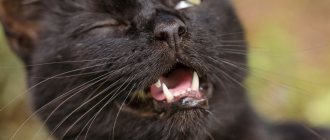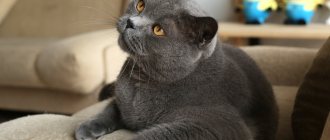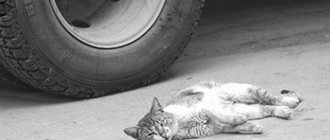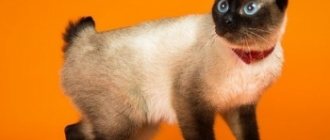Despite the fact that cats evoke a lot of positive emotions in us humans, they are not inclined to express their own feelings too violently. To correctly determine a pet’s mood, owners need to learn to understand cat body language: the position of the animal’s body and movements of the tail very eloquently express its desires and needs. Knowing the characteristics of cat behavior will help you quickly understand how to understand a cat by gestures.
The tail is pipe-shaped and slightly rounded at the tip.
Sometimes it seems that the cat and his tail live separately, each on his own. The animal can be in a calm, motionless state, while the tail often flutters upward, rhythmically walks around or lightly taps on the floor. And all because this part of your pet’s body is a means of expressing emotions and the main assistant in communication. If it is in a vertical position, incl. with a slightly rounded tip, this is a good sign. It notifies others about the friendly, playful mood of the purr, which is ready to communicate with them.
How to understand a cat by meowing
By meowing you can understand the whole spectrum of emotions felt by a cat. Cats express most of their emotions through gestures or facial expressions. Cats use sounds to emphasize their state or the emotions they are experiencing. In most cases, cats purr. This is a special sound created not by all vocal cords, but by vibrations in the upper register. The main purpose of purring is to express peace and love for the owner.
Note! Some owners note that the cat begins to purr, expressing its dissatisfaction or resentment.
A cat can not only purr, but also hiss, howl, chirp and make crackling sounds.
- Short cooing-like sounds are made by cats after a hearty meal, as well as while being stroked by their owner or in anticipation of a treat.
- Hissing means that the animal does not want to make contact, is very frightened and is ready to attack.
- howl and grumble during the onset of hunting. The animal shows its condition and calls the opposite sex.
- By meowing in high notes , a cat or cat is trying to attract its owner or a stranger.
- Specific sounds of chirping and crackling can be made by cats calling their grown kittens.
- But when a cat purrs with its mouth closed , it means full readiness for procreation.
Cats can produce many different sounds, differing in pitch, length and sound timbre. They are all different, but in most cases, loud sounds emitted express negative emotions, while soft and quiet ones indicate good spirits and mood.
If the animal begins to scream, making heartbreaking sounds, then this indicates that the cat requires help. Perhaps something hurts her. In addition, sharp, intense sounds made by an animal indicate a feeling of fear or anger.
Tail tucked between hind legs
If the tail is tucked between the hind legs, the cat is probably frightened by something, as if a person's eyes suddenly widened from something he saw or heard. Loud or unusual noises, unfamiliar people or animals suddenly appearing on your pet's territory - any of these events can cause such a reaction. But if nothing unusual is happening around, this gesture may mean that the animal is concentrating its attention on something interesting to it, for example, on the appetizing aroma of fish.
Not all tailless cats have the same “tailless gene.”
The gene leading to taillessness in Manx is dominant. This automatically causes the absence of a tail if the kitten has at least one such gene. If the kittens are homozygous (with two copies of the tailless gene), the pregnancy will usually abort spontaneously, so Manx tailless cats are bred from one tailed and one tailless parent. But even kittens with one gene have an increased risk of developing a disease called Manx syndrome, which is characterized by spina bifida, fusion of the vertebrae, and problems with the intestines and bladder. In contrast, the gene that is responsible for the Japanese Bobtail's short, broken, and curved tail is recessive—you need to have two copies of it for it to work. In addition, the bobtail gene does not cause the same health problems as the Manx gene.
Legends have long been formed about the independent and self-sufficient nature of cats. And for good reason, because this is the only wild animal that agrees to live next to humans. Making friends with a cat is easy - all you need is a little time, patience and observation. And most importantly, always respect her interests and personal space.
It is not difficult to understand what exactly she wants to tell you. Body language, gaze, sounds, facial expressions - these are all the things with which the cat tries to “get through” to you, talking like a foreigner who doesn’t know the language well - slowly and clearly. Cats use more than 25 body positions, for all occasions.
Pose
- Straight back, light, dancing gait, high-raised vibrating tail - “Bliss! I'm happy with life."
- The cat persistently touches you with its paw - take a closer look, it wants something from you!
- Gently stroking you - pleasure, gratitude.
- A cat “butts” you with its head is a very eloquent gesture of gratitude.
- Arched back, fur standing on end, ears flattened - rage, . The cat is very scared and wants to appear “big and scary.” At the same time, in small kittens this same pose can mean “play with me, please!”
- Handling the owner's stomach or knees with his paws, the so-called “milk step”. This is how kittens get milk from their mother cat. An adult animal thus expresses its sincere affection for you. “I feel so good and cozy!” - she seems to say.
- The cat persistently rubs against your legs - take a closer look, she really needs something from you! This is how pets attract the attention of their owners. It’s also quite possible that she “marks” you with her scent in this way.
- The cat lies on its side or back, opening its belly - a trusting or fighting pose, depending on the circumstances. In relation to the owners or other cats, this is a gesture of complete trust. But this can also be a sign of threat towards enemies - dogs or other predators. In such a situation, the cat rolls onto its back, freeing all 4 paws for attack.
- Sits in one place, turning to you - a request. For example, if she sits at the door like this, “Open the door, please!” Sits by the bowl - “Give me something to eat, give me!”
- Hides his head during the game - a variant of the game of hide and seek. “Come on, try to find me!”
- Turns his back to you, raising his tail high - absolute trust, gratitude. The same is true if the cat is sitting with its back turned to you.
Paws
- Bent front paws - the cat is angry and ready to attack.
- Bent hind legs - the cat is very scared. This pose signifies self-doubt and fear.
- The cat is holding a relaxed front paw in the air - confusion. She seems to be asking: “What is this?!”
- Gently touches you with his paw, or smoothly reaches it towards your face - interest. The cat really wants attention and affection from you.
- Scratching something loudly with its claws attracts attention.
Head
- The cat “nods” its head several times as part of the greeting pose. Along with a high tail and a welcoming purr.
- With its head stretched forward, the cat is ready to communicate with you. She seems to say: “Well, what do you want?”
- The head is lowered, the cat hides its gaze - fatigue, indifference, apathy. “Well, what else do you need?” - she says.
- A drooping mustache means disappointment, fatigue. It is possible that the cat is sick.
Ears
- Ears pressed to the head - defending or preparing to attack. If you notice such a pose in a cat for no apparent reason, perhaps she has spoiled something and is afraid of your reaction. At the same time, ears pinned down during play is normal, especially during “hunting” games. And in combination with sudden movements of the tail, the cat is very irritated by something.
- The ears are alert and move like “radars” - interest. The animal listens carefully to what is happening around and assesses the situation.
- Ears twitch sharply - anxiety. Please note that something is clearly bothering your pet. For example, a cat may twitch its ear several times to drive away an annoying insect.
- Ears upright - curiosity. Hence the saying: “ears on top of the head.”
- Ears forward - calm, interest.
Mouth and chin
- A twitching lower lip and chin is a sign of disappointment, annoyance. It often happens if the cat got something tasty, or she missed the prey.
- A cat licks its lips - a familiar eloquent sign of pleasure after the animal has eaten something tasty. But sometimes it can be a signal of anxiety or interest in something unfamiliar.
- The tip of a relaxed tongue is visible - bliss! The cat is relaxed and in the most complacent mood.
- At the same time he licks his lips and us - confusion, confusion.
- Quick licking of one front paw – excitement, confusion. The cat is gaining time, not knowing what to do.
- He licks himself defiantly, turning his back to you - an insult. The cat clearly tells you: “You made me feel bad, I’m very offended!”
Eyes
- Dilated pupils during the day, in bright light, are a sign of alertness. And in combination with a lowered head, flattened ears, and an unblinking gaze - a clear message “Don’t touch me! Otherwise it will be very bad for you...”
- Half-closed eyes are a sign of trust, friendliness and comfort. The cat is not in danger, she is calm, relaxed, and immersed in her dreams...
- The direct “unseeing” gaze of a calmly sitting cat is an analogue of sleep with open eyes.
- Blinking his eyes slowly is a sign of affection and affection for you. It would be the same if the cat gave you a friendly wink.
- Dozing, sitting with his eyes closed - peacefulness, bliss.
- The eyes are closed, but the ears are pressed to the head - impatience. “Well, hurry up, hurry up!” - says the cat.
- Large eyes combined with flattened ears are a warning, a threat. The cat is scared and ready to attack.
- Large eyes combined with wide pupils during the day mean fear. The cat is paralyzed with terror.
Tail
- Tail raised high, fluttering - everything is fine. Life is good!
- The tail is raised high in a sharp movement - a greeting. This is how cats greet other cats and people.
- The tail is raised at the top with a curved tip - one of the elements of the dominant pose. This is how a cat walks down the street, considering itself the owner of this territory.
- The tail is raised high, but the tip is relaxed - joy. "Life is Beautiful!"
- The tail sways from side to side - dissatisfaction, irritation. The amplitude can vary - from the tip of the tail barely moving (slight dissatisfaction) to the moment when the cat whips itself on the sides with its tail in rage.
- The tail is lowered and ruffled - alertness, anxiety. The cat clearly doesn't know what to do in this situation.
- The tail froze motionless below - disgust. The cat seems to be asking: “What kind of disgusting thing is this?!”
- Tail clamped between paws - extreme horror, panic. The animal really needs your help and support!
- A high, tense tail with fluffy hair is aggression. The cat clearly considers herself the main one in the house, and clearly demonstrates to you who is the “leader of the pride” here.
- The cat moves the tip of its tail - curiosity. It can often be observed when your pet is hunting, or during “hunting” games.
Alarm Signals
- Heavy breathing with an open mouth - overheating, extreme fatigue, pain.
- Nervous “wave” in the fur – constant irritation, anxiety, fear.
- The third eyelid is visible - an alarming signal! The cat is very tired, wants to sleep or is sick.
- Ears droop in different directions on the sides of the head - relaxation, apathy, severe fatigue. “I’m exhausted...” says the cat.
And the most important thing is the voice.
The vocal capabilities of cats are extremely rich, and are not limited to the banal “meow”, as most people think. A cat can pronounce more than 15 sounds. Of these, the main ones are 8 consonants (“m”, “n”, “p”, “g”, “x”, “f”, “v”, “r”) and 3 vowels (“a”, “o” ", "y")
Even the usual “meow” can be pronounced differently by a cat, depending on what it wants to say – from a short “hello!” until the hearts said “get out!”
When talking to a person, a cat begins with monosyllabic expressions - for example, “MR!” If you don’t understand exactly what they want from you, the cat becomes more eloquent. She expands the range of sounds, vowels appear in her speech - for example, “m-u-r-r-r!”
- Low sounds in a cat's voice express fear and aggression, high sounds - pleasure.
- Meowing is most often a greeting or request.
- An intermittent “me-oo!” turning into a squeal - the cat responds to your words.
- Purring is not only a sign of pleasure. She may well be excited, sad or irritated by something. By purring, a cat calms and relaxes itself and you. Even seriously ill and dying cats can purr.
- Calm purring is a pleasure.
- Dissatisfied purring - pain, suffering.
- A quiet dissatisfied purr, turning into a distinct rumbling - “Pay attention! My patience is running out!”
- A short “mr!”, depending on the intonation - attracting attention or asking a question.
- Questioning purring - the cat really needs your attention!
- Rumbling - an animal is dissatisfied with something.
- Howl – anger, strong irritation.
- A short cry - the cat is scared.
- A long cry – pain, despair, aggression.
- Hissing, snorting, grumbling - all these are sounds with which a cat expresses its displeasure or irritation. Moreover, with a hiss the cat warns: “Don’t come near me!”, and with a snort it drives away potential enemies (“I’ll attack now!”). If this does not help, the cat switches to grumbling - the last warning before a furious growl.
- Clattering of teeth is a peculiar sound that signifies disappointment and annoyance. It can often be heard from a cat when she is watching birds or chasing flies. It can be roughly translated as: “Oh shit, five didn’t work out!” What a shame!
What you shouldn’t do
If you don’t want to ruin your relationship with your pet once and for all, never:
- don't yell at him
- do not hit him - even symbolically, with a rag or newspaper! The cat will never forgive you for this
- do not wake a sleeping cat unless absolutely necessary
- do not disturb her while eating, when she is resting or washing herself
- Do not allow children to mistreat the cat or disturb it. “He’s still small” is not an excuse. If you get an animal, take the time to explain to your child what is good and what is bad.
The tail is a part of the body that represents the end of the spine, covered with muscles and skin.
The man doesn’t have a tail; it fell off at some point because he was no longer needed.
The tail pipes and vibrates
A vertically positioned vibrating tail indicates pleasure and a state of bliss in which the pet is, for example, when meeting its owners after a long day of work. This gesture can often be seen in kittens who are exploring the world around them or happily running towards a bowl of milk. Young animals often show their pleasure this way during active play with some kind of bait.
All these gestures are quite easy to remember; all that remains is to react correctly to the pet’s behavior. For an observant owner, recognizing a cat's behavior at home will be easy. This way you can understand what exactly pleases or annoys your pet and increase the comfort of living with him.
Like and subscribe to us on Yandex.Zen to receive new materials!
Cat sign language
Cats and kittens can express their attitude and emotional state not only with the help of their ears and voice. With the help of body language, cats can show their friendly attitude, humility, peace, arrogance, resentment and other emotions.
Having shouted or offended his pet in some other way, a person notices that the cat turns its whole body in the opposite direction from him, not paying attention to calls and appeals. Experts say that this is not so much an indicator of arrogance and arrogance as a fear of meeting the eyes of an angry owner.
When a cat shows its belly , it is a signal of a friendly attitude and a special degree of trust. The animal is in a good, playful mood and will, with great pleasure, allow itself to be stroked and cuddled.
In cases where a cat arches its back and raises the hair on its nape and tail, we can confidently say that the animal is ready for an attack and a fierce battle. On the contrary, if the pet tries to hug the floor, bend its ears and tail in order to appear visually smaller, it means that the cat does not intend to communicate and wants to be left alone.











